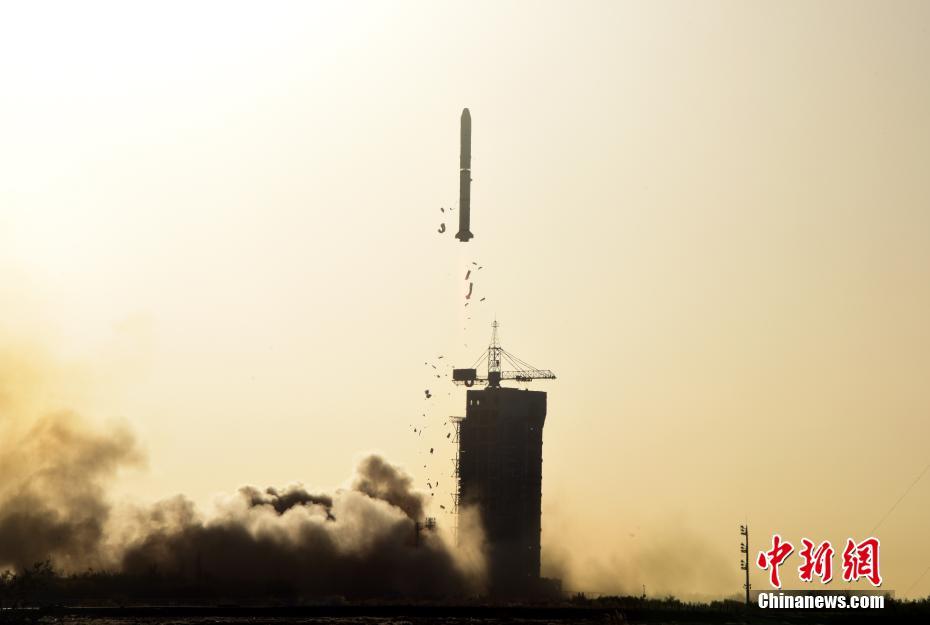


JIUQUAN, Oct. 29 (Xinhua) -- China sent an ocean-observing satellite successfully into space on Monday, a joint mission pursued under Sino-French space cooperation that will enable scientists to study, for the first time, ocean surface winds and waves simultaneously.
The China-France Oceanography Satellite (CFOSat), atop a Long March-2C carrier rocket, took off at 8:43 a.m. from Jiuquan Satellite Launch Center, in northwest China's Gobi Desert, and entered a sun-synchronous orbit 520 km above the Earth.
Jointly developed by the China National Space Administration (CNSA) and the Centre National d'Etudes Spatiales, the French space agency, the satellite will conduct 24-hour observations of global wave spectrum, effective wave height, and ocean surface wind field, said Zhao Jian, a senior official with CNSA.
INNOVATIVE TECHNOLOGIES
As the first satellite cooperation between China and France, the CFOSat is equipped with the world's most advanced technologies.
It carries two innovative radar instruments -- a wind scatterometer developed by China to measure the strength and direction of winds and a wave spectrometer developed by France to survey the length, height, and direction of waves, according to Wang Lili, chief designer of the satellite with the China Academy of Space Technology.
The two instruments will help scientists collect data about winds and waves of the same location simultaneously for the first time, Wang said.
Winds generate waves, and waves, in turn, modify the surface layer of the atmosphere above the ocean. Therefore, more and more often, meteorological and wave forecasts take into consideration the modeling and prediction of both ocean surface winds and waves.
Related forecasts have been enhanced significantly in the last decade, but the prediction accuracy still needs to be improved, especially in extreme events, such as hurricanes, typhoons, and rapidly evolving storms.
The CFOSat, complementing other existing oceanography satellites, will study the dynamics of waves and how they interact with surface winds, and deepen our understanding of their formation and physical mechanism, said Zhao Jian with CNSA.
"It will help increase the observation and prediction of catastrophic sea states, such as huge waves and tropical storms, and provide security support for offshore operations and engineering, ship navigation, fisheries, and coastal management," Zhao said.
By gaining new insights into the impacts of winds and waves on the atmosphere-ocean exchanges that play a key role in the climate system, the satellite will also provide basic information for global climate change research, he added.
China has previously launched six oceanic satellites, with the first officially approved to be developed in 1997. Two other satellites, the HY-1C and the HY-2B, were also sent into space this year ahead of the CFOSat.
"There are now five China-developed oceanic satellites in orbit, each having its own strength in monitoring ocean color, dynamics or sea states. They will complement each other and form a comprehensive observation network to continuously cover the global oceans for various statistics and with high resolution," Zhao said.
"The data they acquire, of remarkable social and economic benefits, will play an important role in protecting ocean environments, exploiting marine resources, preventing and reducing marine disasters, as well as improving marine science research," he said.

 Award-winning photos show poverty reduction achievements in NE China's Jilin province
Award-winning photos show poverty reduction achievements in NE China's Jilin province People dance to greet advent of New Year in Ameiqituo Town, Guizhou
People dance to greet advent of New Year in Ameiqituo Town, Guizhou Fire brigade in Shanghai holds group wedding
Fire brigade in Shanghai holds group wedding Tourists enjoy ice sculptures in Datan Town, north China
Tourists enjoy ice sculptures in Datan Town, north China Sunset scenery of Dayan Pagoda in Xi'an
Sunset scenery of Dayan Pagoda in Xi'an Tourists have fun at scenic spot in Nanlong Town, NW China
Tourists have fun at scenic spot in Nanlong Town, NW China Harbin attracts tourists by making best use of ice in winter
Harbin attracts tourists by making best use of ice in winter In pics: FIS Alpine Ski Women's World Cup Slalom
In pics: FIS Alpine Ski Women's World Cup Slalom Black-necked cranes rest at reservoir in Lhunzhub County, Lhasa
Black-necked cranes rest at reservoir in Lhunzhub County, Lhasa China's FAST telescope will be available to foreign scientists in April
China's FAST telescope will be available to foreign scientists in April